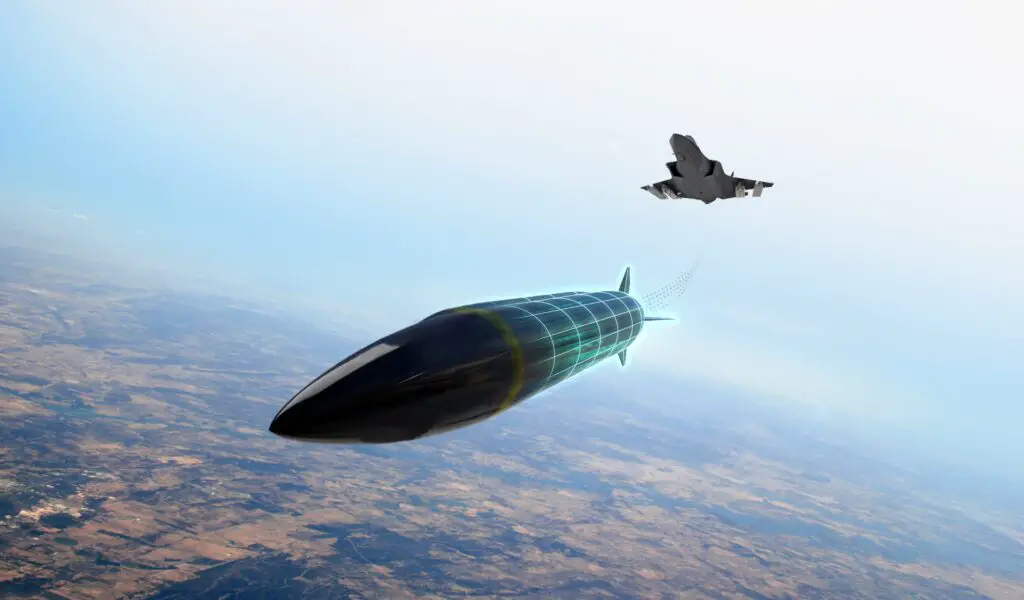Northrop Grumman will develop and test a new supersonic air-to-ground missile dubbed SiAW (Stand-in Attack Weapon) for the United States Air Force (USAF). This missile will be fired by multirole fighters such as the F-35 and the B-21 Raider. Its mission is to penetrate the adversary’s most advanced air defence systems.
The missile can be stowed in the F-35’s internal weapon bays without compromising the aircraft’s stealth characteristics, increasing the aircraft’s aerodynamic drag and affecting the maximum speed and manoeuvrability. Carrying munitions externally under the wings impedes the F-35’s ability to execute quick, aggressive manoeuvres.
The only air-to-ground missile currently compatible with the F-35’s internal weapon compartments is the Norwegian subsonic JSM (Joint Strike Missile), an air-launched version of the Naval Strike Missile (NSM) designed for naval use. The JSM carries a 120-kilogram fragmentation-piercing warhead with a theoretical range of 550 kilometres when launched from high altitudes. However, the subsonic JSM is relatively vulnerable to modern air defence systems.
In the first phase of the SiAW programme, three companies competed: Northrop Grumman, Lockheed Martin and L3 Harris. Each received $2,000,000 in May 2022 to develop their respective concepts. Northrop Grumman proved successful in the end.
In the programme’s second phase, Northrop Grumman will develop and test SiAW prototypes for $705 million and 36 months. SiAW will be integrated into the F-35A in the testing phase, and actual missile launches will be conducted. During the development, “digital engineering” will play a crucial role, particularly in modelling and simulation – virtual prototypes. The process also entails the complete digitalisation of all documents and the exchange of digital data and models, thus enabling product development and support throughout its lifecycle. Artificial intelligence tools and the processing/analysis of large datasets – Big Data will also play a significant role.
SiAW is aerodynamically, structurally, and dimensionally derived from Northrop Grumman’s AGM-88G AARGM-ER (Advanced Anti-Radiation Guided Missile – Extended Range) anti-radiation missile. The company’s proposal was awarded the contract because there was no need to develop a missile from the beginning.
The AARGM-ER is in service with the US Navy (F-35C, F/A-18E/F) and replaces the AGM-88 HARM (High-Speed Anti-Radiation Missile) and its most recent variant, the AGM-88E AARGM. HARM entered service in the 1980s and was used effectively against hostile radars during Operation Desert Storm.

The parameters of SiAW are classified, including its range and speed. The same is true for the AARGM-ER missile, which, according to unofficial sources, has a range of 300 kilometres and a speed three times that of sound. This is unconfirmed data, and no official information is available. Only the AARGM-ER has substantially greater speed and range than the older Mach 2 capable AGM-88E with 130 kilometres has been mentioned.
Combining mature and tested technologies with digital engineering will expedite the integration of SiAW into the arsenal. The initial operational capability is expected in early 2026. SiAW will be produced on the same assembly line as AARGM-ER.
The US Air Force intends to acquire 400 SiAW missiles in 2028 and up to 3,000 additional missiles in subsequent years.
Given the significant similarities between SiAW and AARGM-ER, the US Air Force will acquire modified AARGM-ER missiles with enhanced payloads that will be integrated into F-35A aircraft as an interim solution. AARGM-ER already employs satellite navigation and has an active radar onboard, allowing it to engage static conventional ground targets.
According to Northrop, SiAW will have an open architecture that enables the rapid modernisation of subsystems to expand capabilities. This suggests the possibility of rapid improvements to computing capacity, electronics, sensors, communication systems, and unquestionably the warhead.
The SiAW programme aims to increase the arsenal of long-range precision air-to-ground munitions. SiAW will supplement more potent and expensive missiles such as the JASSM (Joint Air-to-Surface Standoff Missile), designed to attack “large” static targets. It is comparable to the Storm Shadow and SCALP-EG missiles. However, JASSM can only be transported by F-35 aircraft under their wings.

According to the Pentagon, the SiAW system will be able to target rapidly relocatable threats in Anti-Access/Area Denial (A2/AD) environments. SiAW’s primary objective is to eliminate mobile and rapidly relocatable adversary ground-based air defence systems, particularly S-300/400 systems or shorter-range systems such as Pantsir, Tunguska or Tor. However, smaller munitions with a range of up to 110 kilometres, such as the GBU-53/B Storm Breaker, could be sufficient for these targets.
Other potential targets include all air defence components, such as independent radars, mobile command and control units, fire control systems, communication systems, etc. F-35 aircraft outfitted with SiAW (hence the name “Stand-in”) are intended to operate within the airspace protected by the enemy’s air defence systems.
Eliminating enemy air defences will permit F-35 aircraft to operate freely over enemy territory and employ cost-effective air-to-ground munitions such as JDAM (Joint Direct Attack Munition), Paveway munitions and Storm Breaker.
Various targets fall under the A2/AD (Anti-Access/Area Denial) concept, which incorporates measures to deny an adversary entry into a protected area (across all domains of warfare). These include command centres, launchers for ballistic missiles on the ground and along the coast, launchers for cruise missiles, electronic warfare systems, and anti-satellite systems.
The US Air Force had received 3,609 JASSM missiles as of December 2022. Plans call for the production of up to 10,250 JASSM missiles. Lockheed Martin anticipates producing 45 JASSM missiles per month in 2024, rising to 60 per month and ultimately reaching 85 or 1,000 per year by the decade’s end. Within this category of munitions, the most recent version, JASSM-158D, acquires the ability to engage moving targets, such as trains or large columns of military vehicles.
